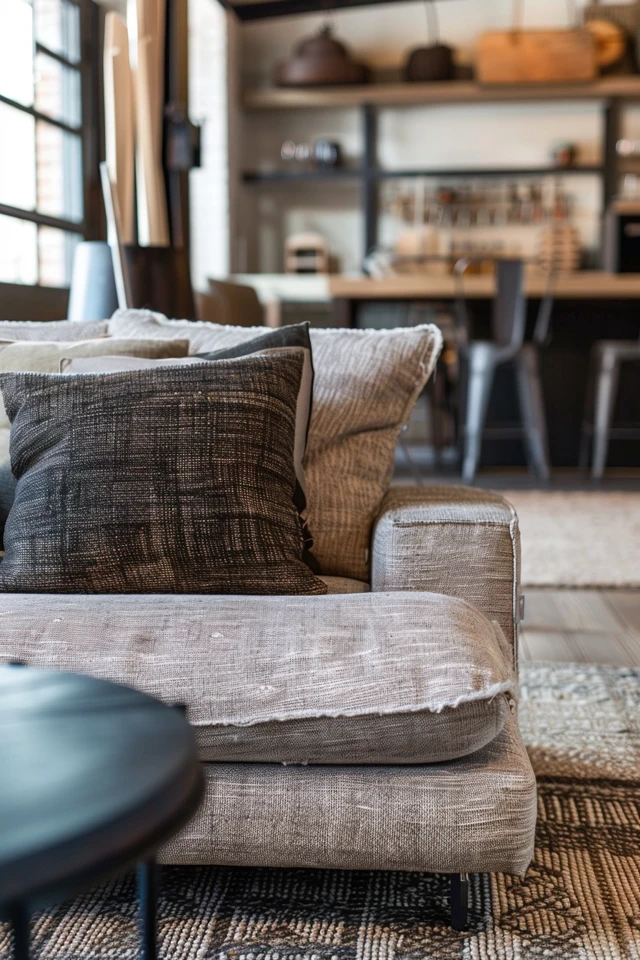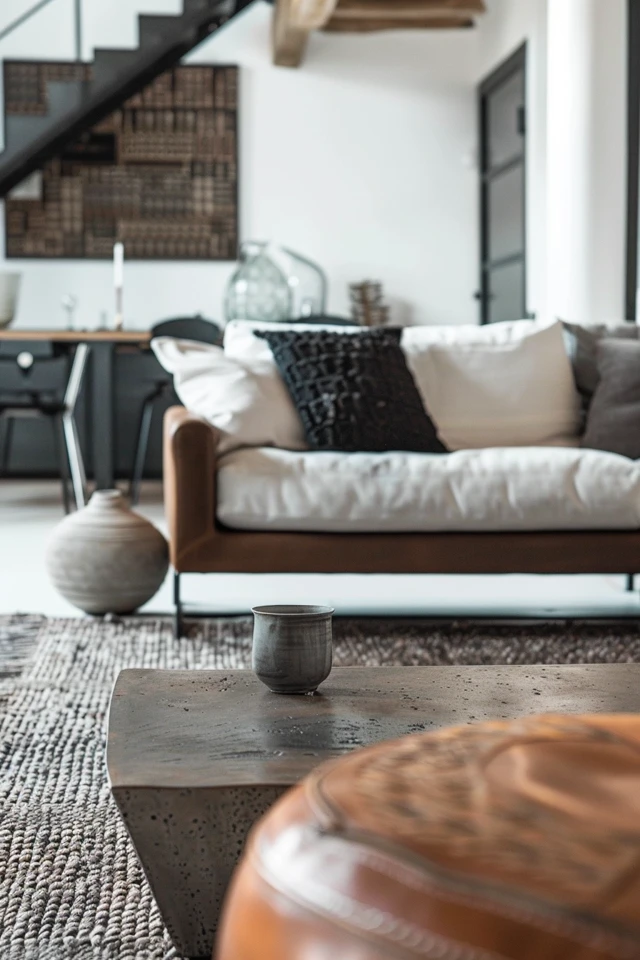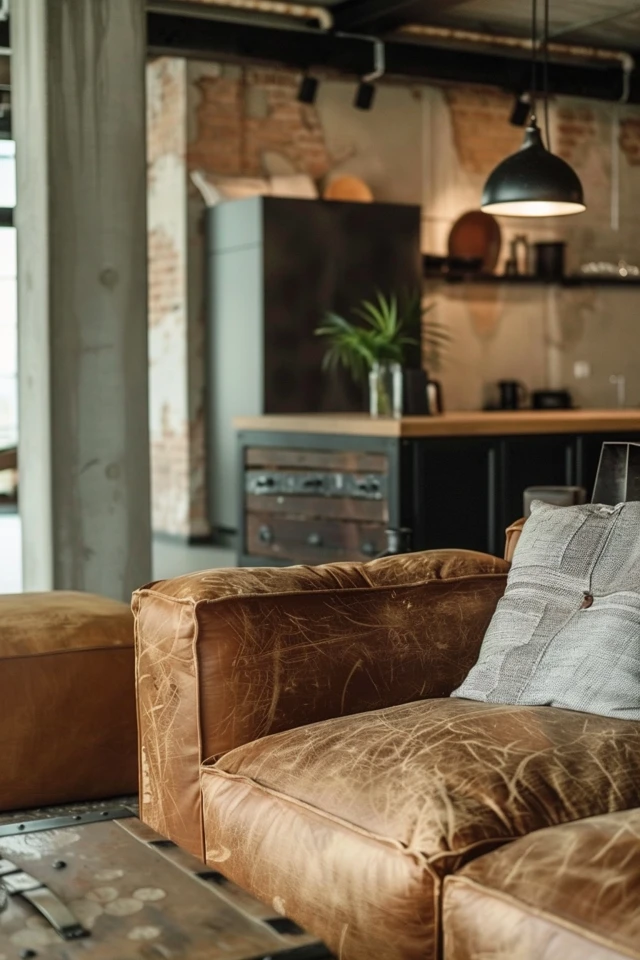Welcome to my guide on industrial design style for chic interiors. Industrial design has become more than just a passing trend; it has evolved into a timeless and ever-evolving aesthetic in the world of interior design. With its combination of raw and industrial elements like metal, reclaimed wood, exposed brick, and concrete, industrial design brings an urban and edgy vibe to any space.
In recent years, modern industrial design has taken center stage, offering a more minimal and contemporary approach compared to its earlier iterations. This style blends different design elements and emphasizes the fusion of modern touches with farmhouse-style materials.
To achieve an industrial look, incorporate visible structural elements, opt for rough wood or concrete floors, and embrace a neutral color palette. The use of raw materials like leather and wood, as well as an emphasis on steel and dark metal, is key to creating an authentic industrial aesthetic. Additionally, high ceilings, large windows, and strategic lighting are characteristic of industrial spaces.
Whether you’re looking to revamp your kitchen, living room, bedroom, or create an industrial-inspired ambiance in a hospitality venue, industrial design offers endless possibilities. By following the right guidelines and incorporating the right elements, you can achieve a sleek and stylish industrial look that is both inviting and on-trend.
Key Takeaways:
- Industrial design is a timeless and evolving style in interior design.
- Key elements of industrial interior design include visible structural elements, rough wood or concrete floors, and a neutral color palette.
- Raw materials like leather and wood, as well as steel and dark metal, are common in industrial design.
- High ceilings, large windows, and strategic lighting are characteristic of industrial spaces.
- To achieve an industrial look, focus on highlighting structural elements, keeping decorations minimal, and incorporating furniture and decor with an industrial influence.
What is Industrial Design?
Modern industrial design is an evolution of the earlier, grittier versions of the style. It incorporates elements of other design styles and redefines the traditional look of industrial spaces. The emphasis is on raw and industrial materials like metal, beams, reclaimed wood, and streamlined materials. The previous versions of industrial design featured more literal decor objects like gears and uncovered light bulbs, but the modern approach is more minimal and sleek. Rustic industrial design is also a popular variation that emphasizes a natural and rustic palette. Industrial architecture plays a significant role in the design style, with visible elements such as exposed brick walls, beams, and open ductwork being key features. The industrial aesthetic is characterized by high ceilings, large windows, and a minimalist spirit.
Modern Industrial Design: Redefining the Look
The modern iteration of industrial design offers a fresh take on the style, incorporating elements from various design genres. It moves away from the grittiness of traditional industrial design and embraces sleekness and minimalism. Raw materials like metal, beams, and reclaimed wood are focal points, while traditional industrial decor objects are replaced with more streamlined elements. This evolution allows for a more versatile and contemporary approach to industrial design in interior spaces.
“Industrial architecture plays a significant role in the design style, with visible elements such as exposed brick walls, beams, and open ductwork being key features.”

Rustic Industrial Design: Embracing Nature and Authenticity
In contrast to modern industrial design, rustic industrial design highlights a natural and rustic aesthetic. It focuses on warm and earthy tones, incorporating elements like distressed wood, aged metals, and vintage finishes. The fusion of raw materials and rustic charm creates a cozy and inviting atmosphere. Rustic industrial design retains the key elements of industrial architecture, with exposed brick walls and beams as prominent features.
“The industrial aesthetic is characterized by high ceilings, large windows, and a minimalist spirit.”
The Role of Industrial Architecture
Industrial architecture plays a crucial role in defining the industrial design style. It showcases visible structural elements such as exposed brick walls, beams, and open ductwork, adding character and authenticity to interior spaces. High ceilings and large windows are common features, creating an open and airy feel. The strong influence of industrial architecture sets the foundation for the industrial design aesthetic.
Elements of Industrial Interior Design.
Industrial interior design incorporates several key elements that define the aesthetic. These elements work together to create a unique and stylish space that exudes a raw and urban charm.
Visible Structural Elements
One of the defining features of industrial interior design is the presence of visible structural elements. Exposed brick walls, exposed beams, and open ductwork are commonly seen in industrial spaces. These elements add texture and character to the design while serving as a nod to the building’s industrial past.
Rough Wood or Concrete Floors
To further enhance the industrial look, rough wood or concrete floors are often used. These types of flooring add to the raw and rough aesthetic of the space. Whether it’s the warmth of wood or the coolness of concrete, these flooring options contribute to the overall industrial feel.
Neutral Color Palette
A neutral color palette forms another important element of industrial interior design. With an emphasis on darker tones, such as shades of gray, black, and brown, a moody and urban atmosphere is created. These colors serve as a backdrop for allowing other elements, such as raw materials and metal accents, to shine.

Raw Materials
Raw materials like leather and wood are frequently incorporated into industrial interior design. From furniture and fixtures to home decor items, the repeated use of these materials adds warmth and an organic touch to the space. These raw materials also contribute to the overall authenticity and character of the industrial aesthetic.
Steel and Metal
Industrial design places a strong emphasis on steel and dark metal. These materials are not only used structurally in beams and columns but also in decoration. Whether it’s exposed metal pipes, metal light fixtures, or metallic accents, the use of steel and metal adds an edgy and industrial touch to the space.
High Ceilings
High ceilings are a characteristic feature of industrial spaces. They create an open and airy feel, adding to the grandeur and sense of spaciousness. Combined with large windows that allow for ample natural light, high ceilings contribute to the overall industrial aesthetic.
Simplicity and Functionality
Industrial interior design is known for its minimalist approach. Simplicity and functionality are key elements of this style. By keeping decorations to a minimum and focusing on the essential elements, industrial spaces maintain a clean and uncluttered look.
To bring these elements to life in your own space, consider incorporating exposed brick walls, rough wood floors, and a neutral color palette. Use raw materials, steel, and metal accents to add character and interest. And don’t forget to celebrate high ceilings and open spaces for that true industrial vibe.

Incorporating Industrial Design into Your Home.
When it comes to transforming your home with an industrial design aesthetic, paying attention to lighting is crucial. The raw materials used in industrial design can sometimes create a cold and stark atmosphere. Therefore, the right lighting choices can add warmth and life to the space.
Industrial style is truly captivating in large areas with high ceilings and plenty of natural light. To enhance this aesthetic, carefully select light fixtures that complement the industrial vibe. Opt for fixtures made from metal or exposed bulbs for an authentic touch.
The color palette for industrial design should consist of dark, neutral tones that reflect a natural and raw ambiance. Avoid bold, artificial colors and stick to shades that mimic the existing elements. By doing so, you will maintain a cohesive and authentic industrial look.
When working with smaller spaces, focus on incorporating one or two impactful industrial elements. Enhance the space with raw construction materials like exposed brick walls or rustic wood beams. Keep decorations minimal and let the industrial features become the focal point.
In terms of furniture and decor, choose pieces that embody the industrial aesthetic. Look for items made from metal, wood, and leather. These materials will add a robust and authentic touch to your space. Accessories such as industrial-style lamps, artwork, and unique finds from flea markets or vintage shops can also help to add industrial elements and personality to your home.
Remember, incorporating industrial design into your space is not about replicating a factory look, but rather adding character and industrial charm. So don’t be afraid to mix styles and infuse personal touches that soften the overall aesthetic while still maintaining the industrial edge.

